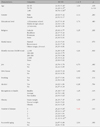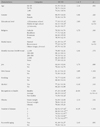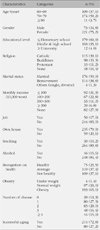Abstract
Purpose
This study was to identify the relation between productive activity and physical and psychological ability in elders.
Methods
A total of 294 subjects aged between 60 and 92 were selected through convenient sampling. Data were collected with a self-reported questionnaire from May to June, 2008. Collected data were analyzed by SPSS/PC Win. 15.0.
Results
Of variance in productive activity, 13.3% was explained by house ownership, number of diseases, and successful aging. Of variance in physical and psychological ability, 25.4% was explained by house ownership, perceived health, number of diseases, and successful aging. The correlation coefficient between productive activity and physical and psychological ability was significant (r=.32, p<.001)
Figures and Tables
Table 2
Difference in Productive Activity according to General and Health-related Characteristics (N=294)

Table 3
Difference in Physical and Psychological Ability according to General and Health-related Characteristics (N=294)

References
1. Everard KM. The relationship between reason for activity and older adult well-being. J Appl Gerontol. 1999; 18:325–340.
2. Ha JY. Study on the relevant variable for successful aging: On the basis of the SOC model of middle class Elderly. Seoul: Kyunghee University;2003. Unpublished master's thesis.
3. Hong HB. Toward a new definition of successful aging through the critical literature review. Seoul: Ewha University;2002. Unpublished doctoral dissertation.
4. Hong HB. The relationship between productive activities and successful aging among the aged. J Welf Aged. 2005; 29:203–235.
5. Horzog AR, Kahn RL, Morgan JN, Jackson JS, Antonucci TC. Age differences in productive activities. J Gerontol. 1989; 44(4):S129–S138.
6. Jang HS. SOC strategies and life-satisfaction in middle and later adulthood. Korean J Psychol Gen. 2007; 20(2):131–144.
7. Kang JA. The effect of old adults productive actiivity on successful aging. Daegu: Daegu University;2006. Unpublished master's thesis.
8. Kim CG, Jang HJ, Kim SS. The correlation between ability of activity in daily living and self-care agency among elderly in Chunchon province. J Korean Acad Adult Nurs. 2001; 13(1):40–52.
9. Kim IH. Phenomenological approach on loneliness of the elderly. Seoul: Kyung Hee University;1995. Unpublished doctoral dissertation.
10. Kim KY, Jung YJ. The study on elements of successful aging by physical health and economic status. J Welf Aged. 2006; 34:31–54.
11. Korean Center for Disease Control and Prevention. 2007 National health statistics: 1st year (2007) of 4th national health and nutrition examination survey. 2008. Retrieved Feb. 2, 2009. from http://knhanes.cdc.go.kr.
12. Lee KO. Structural analysis of successful aging factors of rural elders. Seoul: Seoul National University;2007. Unpublished doctoral dissertation.
13. Lee YB. Study on the factors of life satisfaction. Cheongju: Chungbuk University;1993. Unpublished master's thesis.
14. Lemon BW, Bengtson VL, Peterson JA. An exploration of the activity theory of aging: Activity types and life satisfaction among in-mover to a retirement community. J Gerontol. 1972; 27(4):511–523.
15. Menec VH. The relation between everyday activities abd successful aging: A 6-year longitudinal study. J Gerontol B Psychol Sci Soc Sci. 2003; 58(2):S74–S82.
16. Kim DH, Park EH, Kim SK, Lee HG, Suh YS, Shin DH, et al. Cognitive function, family function and depression in rural elderly. J Korean Acad Fam Med. 1997; 18(8):814–823.
17. Park KB. The effect old adults productive activity on successful aging. Daegu: Daegu University;2008. Unpublished master's thesis.
18. Park MH, Ko JK, Kim ES, Kim HJ, Paik JS, Yang HJ, et al. Geriatric Nursing. Seoul: Jungdam Media Pub;2004.
22. Rowe JW, Kahn RL. Successful aging. New York: Pantheon/Random House;1998.
23. Unger JB, Johnson CA, Marks G. Functional decline in the elderly; Evidence for direct and stress-buffering protective effects of social interactions and physical activity. Ann Behav Med. 1997; 19:152–160.

24. Ryu JR. Study on the effect of the volunteerism for the elderly on the ego-intergrity. Seoul: Seoul National University;2002. Unpublished master's thesis.
25. Seo EJ. Constructing the successful aging model of the older adults. Seoul: Kyung Hee University;2009. Unpublished doctoral dissertation.
26. Strawbridge WJ, Wallhagen MI, Cohen RD. Successful aging and well-being: Self-rated compared with Rowe and Kahn. Gerontologist. 2002; 42(6):727–733.
27. Sung GW. Comparison of ADL and satisfaction state of the elderly in institution and home. J Korea Gerontol Soc. 1999; 19(1):105–117.
28. William JS, Margaret IW, Richard DC. Successful aging and well-being: self-rated compaired with Rowe and Khan. Gerontologist. 2002; 42(6):727–733.




 ePub
ePub Citation
Citation Print
Print






 XML Download
XML Download